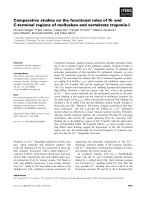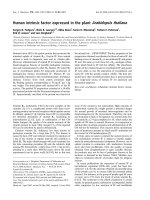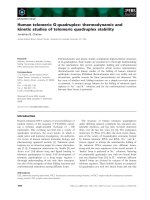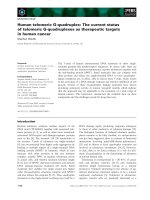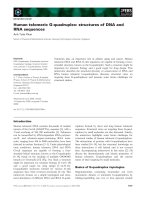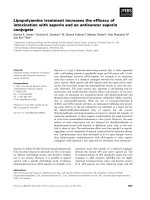Báo cáo khoa học: Human telomeric G-quadruplex: The current status of telomeric G-quadruplexes as therapeutic targets in human cancer pdf
Bạn đang xem bản rút gọn của tài liệu. Xem và tải ngay bản đầy đủ của tài liệu tại đây (284.44 KB, 8 trang )
MINIREVIEW
Human telomeric G-quadruplex: The current status
of telomeric G-quadruplexes as therapeutic targets
in human cancer
Stephen Neidle
Cancer Research UK Biomolecular Structure Group, University of London, UK
Introduction
Human telomeres comprise tandem repeats of the
DNA motif (TTAGGG) together with associated telo-
meric proteins [1–3], as well as other more transiently
associated DNA-repair and damage-response proteins
such as Ku [4]. The terminal 150–250 nucleotides at
the extreme 3¢-ends of telomeres are single-stranded
[5], but are protected from higher order aggregation by
binding to multiple repeats of a single-stranded DNA
binding protein (hPOT1 in humans), which in turn
interacts with other proteins in the core telomere
complex, notably TPP1, to regulate telomerase action
in cancer cells, and thereby maintain telomere length
[6–8]. Loss of hPOT1 deprotects telomeres and initiates
DNA damage-response mediated cell death. Small
molecules that stabilize the single strand into higher
order (G-quadruplex) structures compete with hPOT1
and also initiate this response [9–11]. Thus, quadruplex
formation at the single-strand overhang may itself be a
DNA damage signal, producing responses analogous
to those of other mediators of telomere damage [12].
The biological function of induced telomeric quadru-
plexes remains to be fully clarified; an end-protective
role has been suggested, there is evidence of functional
interactions involving poly(ADP-ribose) polymerase-1
[13] and in ciliates at least, quadruplex structures are
involved in telomerase recruitment [14,15]. However,
to date, there is no direct evidence of a role for telo-
meric G-quadruplexes in the functioning of telomeres
in normal human cells.
Telomerase is overexpressed in 80–85% of cancer
cells and primary tumours [16,17] and maintains
telomere length homeostatis (acting as a tumour
promoter). Telomere shortening in the absence of sig-
nificant telomerase expression appears to be a tumour
suppressor mechanism [3]. Telomeres in telomerase-
negative somatic cells are gradually shortened as a
Keywords
acridine; anticancer; drug; drug-like; in vivo;
medicinal chemistry; pharmacology;
quadruplex; telomerase; telomere
Correspondence
Stephen Neidle, Cancer Research UK
Biomolecular Structure Group, The School
of Pharmacy, University of London,
29-39 Brunswick Square, London
WC1N 1AX, UK
Fax: +44 207 753 5970
Tel: +44 207 753 5969
E-mail:
(Received 25 June 2009, revised 5 October
2009, accepted 6 October 2009)
doi:10.1111/j.1742-4658.2009.07463.x
The 3¢-ends of human chromosomal DNA terminate in short single-
stranded guanine-rich tandem-repeat sequences. In cancer cells, these are
associated with the telomere-maintenance enzyme telomerase together with
the end-binding protein hPOT1. Small molecules that can compete with
these proteins and induce the single-stranded DNA to form quadruplex–
ligand complexes are, in effect, able to expose these 3¢-ends, which results
in the activation of a DNA damage response and selective inhibition of cell
growth. Several of these G-quadruplex binding molecules have shown
promising anticancer activity in tumour xenograft models, which indicate
that the approach may be applicable to the treatment of a wide range of
human cancers. This minireview summarizes the available data on these
compounds and the challenges posed for drug discovery.
1118 FEBS Journal 277 (2010) 1118–1125 ª 2009 The Author Journal compilation ª 2009 FEBS
consequence of the end-replication effect, and once
telomeric DNA is at a critically short length, cells
enter p53 and Rb-dependent replicative senescence,
and ultimately apoptosis. The catalytic subunit of telo-
merase (hTERT in humans) has reverse transcriptase
enzymatic activity and synthesizes TTAGGG repeats
on to the end of the 3¢ single-stranded overhang. Inhi-
bition of hTERT by siRNA, antisense or small-mole-
cule inhibitors selectively inhibits cancer cell growth
and strongly suggests that induction of telomere short-
ening is a viable therapeutic strategy [18].
Folding the single-stranded telomeric DNA substrate
of telomerase into a four-stranded quadruplex struc-
ture inhibits the enzyme’s catalytic activity [19] because
it ensures that the 3¢-end is inaccessible to hybridize
with the telomerase RNA template, the essential first
step in the catalytic cycle. The induction of quadruplex
stabilization and telomerase inhibition by a quadru-
plex-binding small molecule was first demonstrated
using a disubstituted anthraquinone derivative [20].
Many quadruplex-binding ligands have been reported
subsequently [18,21,22], although relatively few have
been evaluated in cell-based assays, or even with reli-
able in vitro telomerase assays [23,24]. The majority of
G-quadruplex ligands contain a polycyclic heteroaro-
matic core, although it is clear that this is not an
essential requirement for quadruplex binding. Several
effective quadruplex-binding ligands do not have this
feature. The cyclic polyamine telomestatin (Fig. 1) was
the first such compound [25] to show both high quad-
ruplex affinity and telomerase inhibitory potency.
More recent reports have demonstrated that nonconju-
gated compounds that are synthetically more accessible
than telomestatin can have potency against telomerase
and quadruplex selectivity [26–29].
Telomeric quadruplex ligands – possible
mechanisms of action
The classic model of telomerase inhibition and conse-
quent telomere attrition leading to senescence and
apoptosis requires that cells with a mean telomere
Fig. 1. Structures of quadruplex-binding
ligands.
S. Neidle G-quadruplexes as cancer drug targets
FEBS Journal 277 (2010) 1118–1125 ª 2009 The Author Journal compilation ª 2009 FEBS 1119
length of 5 kb, a 24 h cell-doubling time and a sub-
sequent loss of 100 nucleotides per round of repli-
cation would reach critical telomere shortening in
40–50 days [30,31]. This was indeed the observation
in dominant-negative telomerase transfection experi-
ments, but would be therapeutically challenging for
human cancer treatment. Initial findings using G-quad-
ruplex ligands showed very different behaviour, with
senescence occurring within 7–10 days after cells were
first treated, and little evidence of concomitant telo-
mere shortening [11,18,32]. This has subsequently been
shown to be characteristic of the G-quadruplex ligand
class as a whole, and the observations of on-target
in vivo activity within clinically useful timescales are
encouraging signs that significant single-agent clinical
utility may be eventually achievable with appropriate
compounds.
The quadruplex-binding acridine ligands BRACO-19
and RHPS4 (Fig. 1), in common with telomestatin,
induce rapid replicative senescence in cancer cells and
activate the same DNA damage response that follows
DNA double-strand breaks. This involves in particular
ATM, p16
INK4a
kinase and p53 pathways [32–35]
which can be visualized by the appearance of charac-
teristic DNA damage foci using an antibody to the
damage response protein cH2AX [36], or by a signifi-
cant population of cells undergoing end-to-end fusions
in metaphase [37]. Such changes are analogous to
those produced when the telomeric protein TRF2 is
knocked out. This response is a consequence of the
displacement of bound proteins from the single-
stranded overhang, chiefly hPOT1, as well as possible
uncapping of telomerase from the ends. There are
likely to be multiple mechanisms involved, some of
which at least have cross-talk between them (Fig. 2).
For example, hPOT1 interacts with the telomeric pro-
tein Tpp1 and facilitates telomere length regulation
by telomerase, and hPOT1 displacement disregulates
telomerase function [7,8]. Also, although the classic
telomerase inhibition model does not appear to be fol-
lowed by G-quadruplex-binding agents, cancer cells
generally have marked telomere length heterogeneity,
with some having extremely short (< 1 kb) telomeres.
It has been suggested that these cells are not only
sensitive to senescence, but also that their viability is
critical to the cell population overall [38,39], although
it is not clear to what extent telomere shortening,
initially considered to be an essential marker of
Fig. 2. Schematic of mechanism of action of the telomeric quadruplex ligand BRACO-19.
G-quadruplexes as cancer drug targets S. Neidle
1120 FEBS Journal 277 (2010) 1118–1125 ª 2009 The Author Journal compilation ª 2009 FEBS
telomerase inhibition, is relevant to the short-term
effects of telomeric G-quadruplex ligands. Q-FISH
studies have shown that telomestatin is localized at
telomeres during replication and importantly, that telo-
mere replication is unaffected in mouse embryonic
fibroblast (i.e. untransformed) cell lines [40].
Validation of a telomeric quadruplex mode of action
involves evidence from a number of assays. The most
important are: (a) high-affinity in vitro telomeric quad-
ruplex binding, with a K
a
value of at least 10
6
m
)1
; (b)
a low level of binding to duplex DNA, with a K
a
value
at least 10
2
less than for telomeric quadruplexes; (c)
selective inhibition of cell growth, with normal human
cell lines being relatively unaffected; (d) senescence; (e)
inhibition of telomerase activity in cells; (f) competitive
inhibition of hPOT1 binding in cells; and (g) evidence
of telomere uncapping in cells from hTERT.
G-quadruplex ligands as drugs
In vivo activity in xenograft cancer models has been
reported to date for few telomeric quadruplex ligands,
notably the trisubstituted acridine compound BRACO-
19 [32], the polycyclic compound RHSP4 [34,35] and
telomestatin [41] (Fig. 1). The telomeric DNA single-
strand overhang is a target for all these compounds, as
judged by the observations of hPOT1 and hTERT
uncapping. To date, none of these molecules has pro-
gressed beyond the experimental stage into clinical
trial, probably in part because these compounds are
insufficiently drug-like. Little data is publicly available
on their ADME ⁄ pharmacokinetic properties.
To date, the development of small molecules as
G-quadruplex binders has been largely based on poly-
cyclic planar aromatic compounds with at least one
substituent terminating in a cationic group [20,21].
Normally two such substituents are required. The
rationale for the planar moiety has been that this
would stack effectively onto planar G-quartets, which
has been confirmed by several crystallographic and
NMR studies of G-quadruplex–ligand complexes [42–
47]. There is no evidence from these studies of classic
intercalation between G-quartets and all analyses con-
cur in finding that ligands stack onto a terminal
G-quartet of a quadruplex. Substituents are normally
short acyclic chains, such as -(CH
2
)
3
- with a terminal
cationic nitrogen-containing group such as diethyl-
amine, pyrrolidine or piperidine. Structure-based drug
discovery does have these few structures as starting
points [42–47], although these also indicate that the
flexibility of the TTA loops is ligand dependent, and
therefore structural information for a given class
of ligand would be highly desirable. Also, there are
no experimental structural data as yet on folded
telomeric DNA sequences containing eight or twelve
TTAGGG repeats (i.e. with two or three consecutive
quadruplexes), which may be more representative of
the totality of the single-stranded overhang, and
which may be important for these ligands being able
to differentiate telomeric quadruplexes from others in
the genome.
It has long been realized that therapeutically effec-
tive quadruplex-binding ligands should have minimal
duplex DNA affinity (and therefore more generalized
toxicity), and assays for duplex:quadruplex selectivity
are routinely performed in many laboratories. The
structural requirements for selectivity have not yet
been fully clarified, but mostly involve those steric fea-
tures that are incompatible with the dimensions of a
double helix. A large number of genomic DNA and
RNA G-quadruplexes may also be drug targets [48–
53], many of which are involved in proliferation. It is
plausible that G-quadruplex-binding molecules even
with relatively modest selectivity between various
G-quadruplexes, may still have utility in cancer
therapeutics, provided they have low toxicity to
normal cells. Of greater practical importance is that
future G-quadruplex ligands are developed with regard
to their ability to be used as drugs, so that they have:
(a) effective and selective tumour uptake and penetra-
tion, (b) acceptable pharmacokinetic characteristics
and metabolism, and (c) a significant therapeutic
window.
The features common to most current quadruplex
ligands, of several cationic charges and large hydro-
phobic surface area, do aid cellular uptake (probably
by active transport mechanisms), but may also enable
a high background of nonspecific binding to cellular
components, and are not consistent with oral bio-avail-
ability (although this in itself may not be an important
goal). The three positive charges on the BRACO-19
molecule are probably a factor in the inability of this
compound to penetrate larger tumours in both the
UXF1138L and A431 xenograft models [32,54]
(Table 1). Compound AS1410 was devised [55] to have
increased hydrophobicity compared with its parent
compound BRACO-19 as a result of modifications to
the substituents at the 9-position. This resulted in an
increase in plasma half-life from 1 to 2 h.
The limited in vivo data available (Table 1) suggest
that telomeric quadruplex ligands may be useful for
the treatment of solid tumours; to date there is very
little data on haematological cancers. Notable findings
include that of single-agent activity for RHSP4 in a
metastatic melanoma model, as well as in a melanoma
line resistant to the platinum drug DDP [56]. RHPS4
S. Neidle G-quadruplexes as cancer drug targets
FEBS Journal 277 (2010) 1118–1125 ª 2009 The Author Journal compilation ª 2009 FEBS 1121
appears able to penetrate significant tumour masses
(Table 1), in accord with its single net positive charge
combined with the relatively small size of this mole-
cule.
Data on two other quadruplex-binding ligands have
also been included. The porphyrin compound
TMPyP4, which does bind with high affinity to a wide
range of quadruplex nucleic acids, albeit with low
selectivity, has been reported to show anticancer activ-
ity in MX-1 mammary tumours and PC-3 human pros-
tate carcinomas [57]. Although quadruplexes in the
promoter region of the c-myc oncogene have been
suggested as a target for this compound, it is also an
established telomerase inhibitor, so action at the
telomere level should not be ruled out. In vivo data on
the recently described quadruplex-binding fluoroquino-
lone derivative Quarfloxin (CX-3543) is included. It is
currently in clinical trials so its pharmacological profile
has relevance to other quadruplex ligands. This agent
was initially suggested to be targeting a c-myc pro-
moter quadruplex, but is now believed to function by
selectively disrupting nucleolin ⁄ rDNA quadruplex
complexes [58]. It does not show the cellular behaviour
characteristic of a telomere targeting agent.
It is encouraging for future clinical applications that
several G-quadruplex ligands show in vivo synergistic
activity (Table 2) with conventional cytotoxic agents,
such as cis-platinum, taxol and camptothecin deriva-
Table 1. Selected in vivo data on quadruplex-binding ligands. Tumour responses have been estimated from survival curves and other avail-
able data. Single-agent studies. i.p., intraperitoneal; i.v., intravenous.
G4 ligand Xenograft model
Mean initial
tumour size
Dosage
(mgÆkg
)1
) Tumour response
Days to
complete
response Ref
TMPyP4 MX-1 mammary tumor 100 mg
a
10, 20; i.p. Survival increase from
45% to 75%
60 57
TMPyP4 PC-3 human prostate
carcinoma
60 mg 40; i.p. 60% tumour shrinkage 18 57
Telomestatin U937 human lymphoma 1395 mm
3
15 80% tumour shrinkage 21 41
BRACO-19 UXF1138L human uterine
carcinoma
68 mm
3
2; i.p. 96% tumour shrinkage
+ some complete
remissions
28 32
BRACO-19 A431 human epithelial
carcinoma
1080 mm
3
2; i.p. Not significant – 54
Quarfloxin MDA-MB-231 human
breast cancer
> 125 mm
3
6.25, 15.5; i.v. 50% tumour shrinkage 37 58
Quarfloxin MIA PaCa-2 human
pancreatic cancer
> 125 mm
3
5; i.v. 59% tumour shrinkage 35 58
RHPS4 UXF1138L human uterine
carcinoma
5 · 5 mm 5; oral 30% tumour shrinkage 28 33
RHPS4 M14, LP, LM melanoma 300–350 mg 10; i.p. 40–51% tumour weight
reduction
15 56
RHPS4
b
CG5 breast carcinoma 300 mg 15; i.v. 75% tumour shrinkage 30 35
a
Animals were initially treated with cyclophosphamide to minimize tumour burden.
b
RHPS4 was reported to have an antitumour effect in a
number of other tumour types in this study.
Table 2. In vivo studies of quadruplex-binding ligands in combination with established anticancer drugs. Tumour responses have been
estimated from survival curves and other available data. Studies in combination with established anticancer drugs.
G4 ligand Xenograft model
Initial tumour
size
Dosage
(mgÆkg
)1
) Drug 2 Tumour response Ref
BRACO-19 A431 epidermal carcinoma 1080 mm
3
2 Paclitaxel 68% tumour shrinkage 54
AS1410 A549 lung carcinoma 10 mm
3
1 Cis-platinum 75% tumour shrinkage 59
RHPS4 UXF1138L human uterine
carcinoma
5 · 5 mm 5 Taxol Complete remissions 33
RHPS4
a
HCT116, HT29 colorectal
carcinomas
300–350 mg 10 Irinotecan 80% tumour weight reduction 56
a
A number of other combinations, with a range of anticancer drugs, were also reported in this study.
G-quadruplexes as cancer drug targets S. Neidle
1122 FEBS Journal 277 (2010) 1118–1125 ª 2009 The Author Journal compilation ª 2009 FEBS
tives [33,54,56,59], although the detailed mechanism of
this effect remains to be established. The order in
which the drugs are administered appears to be an
important determinant of whether a particular combi-
nation is synergistic or antagonistic. It is also possible
that quadruplex-binding ligands can have multiple
quadruplex targets, which could confer therapeutic
advantage. Dual targeting has been reported for a
substituted naphthalene diimide, which interacts with
quadruplexes in the promoter region of the c-kit onco-
gene that is disregulated in gastrointestinal cancer cells
(inhibiting c-kit expression), and telomeric quadruplexes.
The inhibition of c-kit expression and telomerase activ-
ity take place at the ligand concentrations required to
halt cell growth and proliferation [60].
Acknowledgement
I am grateful to Cancer Research UK for Programme
Grant support and a Professorial Fellowship, and to
my colleagues for their input to the work described in
the references.
References
1 Moyzis RK, Buckingham JM, Cram LS, Dani M,
Deaven LL, Jones MD, Meyne J, Ratliff RL & Wu
JRA (1988) Highly conserved repetitive DNA sequence,
(TTAGGG)
n
, present at the telomeres of human chro-
mosomes. Proc Natl Acad Sci USA 85, 6622–6626.
2 Blackburn EH (2001) Switching and signaling at the
telomere. Cell 106, 661–673.
3 Stewart SA & Weinberg RA (2006) Telomeres: cancer
to human aging. Annu Rev Cell Dev Biol 22, 531–557.
4 d’Adda di Fagagna F, Teo SH & Jackson SP (2004)
Functional links between telomeres and proteins of the
DNA-damage response. Genes Dev 18, 1781–1799.
5 Wright WE, Tesmer VM, Huffman KE, Levene SD &
Shay JW (1977) Normal human chromosomes have
long G-rich telomeric overhangs at one end. Genes Dev
11, 2801–2809.
6 Zaug AJ, Podell ER & Cech TR (2005) Human POT1
disrupts telomeric G-quadruplexes allowing telomerase
extension in vitro. Proc Natl Acad Sci USA 102 , 10864–
10869.
7 Denchi EL & de Lange T (2007) Protection of telo-
meres through independent control of ATM and ATR
by TRF2 and POT1. Nature 448, 1068–1071.
8 Miyoshi T, Kanoh J, Saito M & Ishikawa F (2008)
Fission yeast Pot1–Tpp1 protects telomeres and
regulates telomere length. Science 320, 1341–1344.
9 Gomez D, O’Donohue MF, Wenner T, Douarre C,
Macadre J, Koebel P, Giraud-Panis MJ, Kaplan H,
Kolkes A, Shin-Ya K et al. (2006) The G-quadruplex
ligand telomestatin inhibits POT1 binding to telomeric
sequences in vitro and induces GFP–POT1 dissociation
from telomeres in human cells. Cancer Res 66,
6908–6912.
10 Gomez D, Wenner T, Brassart B, Douarre C, O’Don-
ohue MF, El KV, Shin-Ya K, Morjani H, Trentesaux
C & Riou J-F (2006) Telomestatin-induced telomere
uncapping is modulated by POT1 through G-overhang
extension in HT1080 human tumor cells. J Biol Chem
281, 38721–38729.
11 Gunaratnam M, Greciano O, Martins C, Reszka AP,
Schultes CM, Morjani H, Riou JF & Neidle S (2007)
Mechanism of acridine-based telomerase inhibition
and telomere shortening. Biochem Pharmacol 74, 679–
689.
12 d’Adda di Fagagna F & Reaper PM (2003) A DNA
damage checkpoint response in telomere-initiated senes-
cence. Nature 426, 194–198.
13 Soldatenkov VA, Vetcher AA, Duka T & Ladame S
(2008) First evidence of a functional interaction between
DNA quadruplexes and poly(ADP-ribose) polymerase-
1. ACS Chem Biol 3, 214–219.
14 Paeschke K, Juranek S, Simonsson T, Hempel A,
Rhodes D & Lipps HJ (2008) Telomerase recruitment
by the telomere end binding protein-b facilitates
G-quadruplex DNA unfolding in ciliates. Nat Struct
Mol Biol 15, 598–604.
15 Lipps HJ & Rhodes D (2009) G-quadruplex structures:
in vivo evidence and function. Trends Cell Biol 19, 414–
422.
16 Kim NW, Piatyszek MA, Prowse KR, Harley CB, West
MD, Ho PL, Coviello GM, Wright WE, Weinrich SL
& Shay JW (1994) Specific association of human telo-
merase activity with immortal cells and cancer. Science
266
, 2011–2015.
17 Shay JW & Wright WE (2006) Telomerase therapeutics
for cancer: challenges and new directions. Nat Rev Drug
Discov 5, 577–584.
18 de Cian A, Lacroix L, Douarre C, Temime-Smaali N,
Trentesaux C, Riou J-F & Mergny J-L (2008)
Targeting telomeres and telomerase. Biochimie 90,
131–155.
19 Zahler AM, Williamson JR, Cech TR & Prescott DM
(1991) Inhibition of telomerase by G-quartet DNA
structures. Nature 350, 718–720.
20 Sun D, Thompson B, Cathers BE, Salazar M, Kerwin
SM, Trent JO, Jenkins TC, Neidle S & Hurley LH
(1997) Inhibition of human telomerase by a G-quadru-
plex-interactive compound. J Med Chem 40, 2113–2116.
21 Monchaud D & Teulade-Fichou MP (2008) A hitch-
hiker’s guide to G-quadruplex ligands. Org Biomol
Chem 6, 627–636.
22 Ou T, Lu Y, Tan J, Huang Z, Wong K & Gu L (2008)
G-quadruplexes: targets in anticancer drug design.
ChemMedChem 3, 690–713.
S. Neidle G-quadruplexes as cancer drug targets
FEBS Journal 277 (2010) 1118–1125 ª 2009 The Author Journal compilation ª 2009 FEBS 1123
23 De Cian A, Cristofari G, Reichenbach P, De Lemos E,
Monchaud D, Teulade-Fichou MP, Shin-Ya K, Lacroix L,
Lingner J & Mergny JL (2007) Re-evaluation of telomerase
inhibition by quadruplex ligands and their mechanisms of
action. Proc Natl Acad Sci USA 104, 17347–17352.
24 Reed J, Gunaratnam M, Beltran M, Reszka AP, Vilar
R & Neidle S (2008) TRAP-LIG, a modified telomere
repeat amplification protocol assay to quantitate telo-
merase inhibition by small molecules. Anal Biochem
380, 99–105.
25 Kim MY, Vankayalapati H, Shin-Ya K, Wierzba K &
Hurley LH (2002) Telomestatin, a potent telomerase
inhibitor that interacts quite specifically with the human
telomeric intramolecular G-quadruplex. J Am Chem Soc
124, 2098–2099.
26 Moorhouse AD, Santos AM, Gunaratnam M, Moore
M, Neidle S & Moses JE (2006) Stabilization of G-
quadruplex DNA by highly selective ligands via click
chemistry. J Am Chem Soc 128, 15972–15973.
27 Drewe WC, Nanjunda R, Gunaratnam M, Beltran M,
Parkinson GN, Reszka AP, Wilson WD & Neidle S
(2008) Rational design of substituted diarylureas: a
scaffold for binding to G-quadruplex motifs. J Med
Chem 51, 7751–7767.
28 Rahman KM, Reszka AP, Gunaratnam M, Haider SM,
Howard PW, Fox KR, Neidle S & Thurston DE (2009)
Biaryl polyamides as a new class of DNA quadruplex-
binding ligands. Chem Commun 4097–4099.
29 Dash J, Shirude PS & Balasubramanian S (2008)
G-quadruplex recognition by bis-indole carboxamides.
Chem Commun 3055–3057.
30 Kelland LR (2007) Targeting the limitless replicative
potential of cancer: the telomerase ⁄ telomere pathway.
Clin Cancer Res 13, 4960–4963.
31 Oganesian L & Bryan TM (2007) Physiological rele-
vance of telomeric G-quadruplex formation: a potential
drug target. BioEssays 29, 155–165.
32 Burger AM, Dai F, Schultes CM, Reszka AP, Moore
MJ, Double JA & Neidle S (2005) The G-quadruplex-
interactive molecule BRACO-19 inhibits tumor growth,
consistent with telomere targeting and interference with
telomerase function. Cancer Res 65 , 1489–1496.
33 Phatak P, Cookson JC, Dai F, Smith V, Gartenhaus
RB, Stevens MF & Burger AM (2007) Telomere uncap-
ping by the G-quadruplex ligand RHPS4 inhibits clono-
genic tumour cell growth in vitro and in vivo consistent
with a cancer stem cell targeting mechanism. Br J
Cancer 96, 1223–1233.
34 Tauchi T, Shin-Ya K, Sashida G, Sumi M, Nakajima
A, Shimamoto T, Ohyashiki JH & Ohyashiki K
(2003) Activity of a novel G-quadruplex-interactive
telomerase inhibitor, telomestatin (SOT-095), against
human leukemia cells: involvement of ATM-dependent
DNA damage response pathways. Oncogene 22, 5338–
5347.
35 Salvati E, Leonetti C, Rizzo A, Scarsella M, Mottolese
M, Galati R, Sperduti I, Stevens MF, D’Incalci M,
Blasco M et al. (2007) Telomere damage induced by the
G-quadruplex ligand RHPS4 has an antitumor effect.
J Clin Invest 117, 3236–3247.
36 Rodriquez R, Mu
¨
ller S, Yeoman JA, Trentesaux C,
Riou J-F & Balasubramanian S (2008) A novel small
molecule that alters shelterin integrity and triggers a
DNA-damage response at telomeres. J Am Chem Soc
130, 15758–15759.
37 Incles CM, Schultes CM, Kempski H, Koehler H, Kel-
land LR & Neidle S (2004) A G-quadruplex telomere
targeting agent produces p16-associated senescence and
chromosomal fusions in human prostate cancer cells.
Mol Cancer Ther 3, 1201–1206.
38 Hemann MT, Strong MA, Hao LY & Greider CW
(2001) The shortest telomere, not average telomere
length, is critical for cell viability and chromosome
stability. Cell 107, 67–77.
39 London
˜
o-Vallejo JA (2008) Telomere instability and
cancer. Biochimie
90, 73–82.
40 Arnoult N, Shin-Ya K & London
˜
o-Vallejo JA (2008)
Studying telomere replication by Q-CO-FISH: the effect
of telomestatin, a potent G-quadruplex ligand. Cytoge-
net Genome Res 122, 229–236.
41 Tauchi T, Shin-ya K, Sashida G, Sumi M, Okabe S,
Ohyashiki JH & Ohyashiki K (2006) Telomerase inhibi-
tion with a novel G-quadruplex-interactive agent, telo-
mestatin: in vitro and in vivo studies in acute leukemia.
Oncogene 25, 5719–5725.
42 Fedoroff OY, Salazar M, Han H, Chemeris VV,
Kerwin SM & Hurley LH (1998) NMR-based model of
a telomerase-inhibiting compound bound to G-quad-
ruplex DNA. Biochemistry 37, 12367–12374.
43 Haider SM, Parkinson GN & Neidle S (2003) Structure
of a G-quadruplex–ligand complex. J Mol Biol 326,
117–125.
44 Gavathiotis E, Heald RA, Stevens MF & Searle MS
(2003) Drug recognition and stabilisation of the paral-
lel-stranded DNA quadruplex d(TTAGGGT)
4
contain-
ing the human telomeric repeat. J Mol Biol 334, 25–36.
45 Campbell NH, Parkinson GN, Reszka AP & Neidle S
(2008) Structural basis of DNA quadruplex recognition
by an acridine drug. J Am Chem Soc 130, 6722–6724.
46 Parkinson GN, Cuenca F & Neidle S (2008) Topology
conservation and loop flexibility in quadruplex–drug
recognition: crystal structures of inter- and intramolecu-
lar telomeric DNA quadruplex–drug complexes.
J Mol Biol 381, 1145–1156.
47 Campbell NH, Patel M, Tofa AB, Ghosh R, Parkinson
GN & Neidle S (2009) Selectivity in ligand recognition
of G-quadruplex loops. Biochemistry 48, 1675–1680.
48 Huppert JL & Balasubramanian S (2007) G-quadru-
plexes in promoters throughout the human genome.
Nucleic Acids Res 35, 406–413.
G-quadruplexes as cancer drug targets S. Neidle
1124 FEBS Journal 277 (2010) 1118–1125 ª 2009 The Author Journal compilation ª 2009 FEBS
49 Todd AK, Johnston M & Neidle S (2005) Highly preva-
lent putative quadruplex sequence motifs in human
DNA. Nucleic Acids Res 33, 2901–2907.
50 Huppert JL & Balasubramanian S (2005) Prevalence of
quadruplex sequences in the human genome. Nucleic
Acids Res 33, 2908–2916.
51 Verma A, Halder K, Halder R, Yadav VK, Rawal P,
Thakur RK, Mohd F, Sharma A & Chowdhury S
(2008) Genome-wide computational and expression
analyses reveal G-quadruplex DNA motifs as conserved
cis-regulatory elements in human and related species.
J Med Chem 51, 5641–5649.
52 Siddiqui-Jain A, Grand CL, Bearss DJ & Hurley LH
(2002) Direct evidence for a G-quadruplex in a pro-
moter region and its targeting with a small molecule to
repress c-MYC transcription. Proc Natl Acad Sci USA
99, 11593–11598.
53 Qin Y & Hurley LH (2008) Structures, folding patterns,
and functions of intramolecular DNA G-quadruplexes
found in eukaryotic promoter regions. Biochimie 90,
1149–1171.
54 Gowan SM, Harrison JR, Patterson L, Valenti M,
Read MA, Neidle S & Kelland LR (2002) A G-quadru-
plex-interactive potent small-molecule inhibitor of telo-
merase exhibiting in vitro and in vivo antitumor activity.
Mol Pharmacol 61, 1154–1162.
55 Martins C, Gunaratnam M, Stuart J, Makwana V,
Greciano O, Reszka AP, Kelland LR & Neidle S (2007)
Structure-based design of benzylamino-acridine com-
pounds as G-quadruplex DNA telomere targeting
agents. Bioorg Med Chem Lett 17, 2293–2298.
56 Leonetti C, Scarsella M, Riggio G, Rizzo A, Salvati E,
D’Incalci M, Staszewsky L, Frapolli R, Stevens MF,
Stoppacciaro A et al. (2008) G-quadruplex ligand
RHPS4 potentiates the antitumor activity of camptot-
hecins in preclinical models of solid tumors. Clin Cancer
Res 14, 7284–7291.
57 Grand CL, Han H, Munoz RM, Weitman S, Von
Hoff DD, Hurley LH & Bearss DJ (2002) The cat-
ionic porphyrin TMPyP4 down-regulates c-myc and
human telomerase reverse transcriptase expression and
inhibits tumor growth in vivo. Mol Cancer Ther 1,
565–573.
58 Drygin D, Siddiqui-Jain A, O’Brien S, Schwaebe M,
Lin A, Bliesath J, Ho CB, Proffitt C, Trent K, Whitten
JP et al. (2009) Anticancer activity of CX-3543: a direct
inhibitor of rRNA biogenesis. Cancer Res, doi:10.1158/
0008-5472.CAN-09-1304.
59 Gunaratnam M, Green C, Moreira JB, Moorhouse AD,
Kelland LR, Moses JE & Neidle S (2009) G-quadruplex
compounds and cis-platin act synergistically to inhibit
cancer cell growth in vitro and in vivo. Biochem Phar-
macol 78, 115–122.
60 Gunaratnam M, Swank S, Haider SM, Galesa K, Res-
zka AP, Beltran M, Cuenca F, Fletcher JA & Neidle S
(2009) Targeting human gastrointestinal stromal tumor
cells with a quadruplex-binding small molecule. J Med
Chem 52, 3774–3783.
S. Neidle G-quadruplexes as cancer drug targets
FEBS Journal 277 (2010) 1118–1125 ª 2009 The Author Journal compilation ª 2009 FEBS 1125

